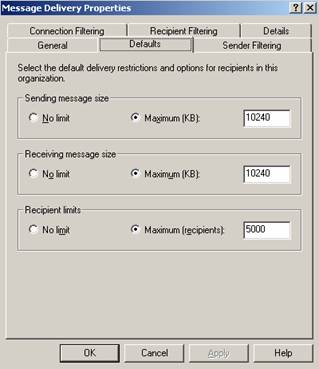

- MAXREQUESTLENGTH SIZE LIMIT EXCHANGE VERSIONS HOW TO
- MAXREQUESTLENGTH SIZE LIMIT EXCHANGE VERSIONS WINDOWS
Run the following command: cscript adsutil.This is a guide on how to configure Exchange Server and edit IIS configuration to enable MAC clients to send attachments with a size over 13mb.

MAXREQUESTLENGTH SIZE LIMIT EXCHANGE VERSIONS WINDOWS
Open a Windows command prompt with administrator rights and navigate to the following location: C:\inetpub\AdminScripts.

To change the maximum message size for ActiveSync clients, you need to change the value of maxRequestLength in the web.config file on Client Access servers and Mailbox servers, MaxDocumentDataSize in the web.config file on Mailbox servers, and maxAllowedContentLength in IIS Manager on Client Access servers and Mailbox servers. After you change the value in IIS Manager, a new maxAllowedContentLength key is written to the corresponding web.config file ( %ExchangeInstallPath%FrontEnd\HttpProxy\Sync\web.config on Client Access servers, and %ExchangeInstallPath%ClientAccess\Sync\web.config on Mailbox servers). You need to change the value on Client Access servers and on Mailbox servers. To change the maxAllowedContentLength value, enter a new value in bytes, and click Apply.
In the results, expand requestLimits, and you’ll see maxAllowedContentLength and the default value 30000000 (bytes). Click the dropdown arrow in the Section field, navigate to system.webServer > security and select requestFiltering. Verify Features View is selected, and double-click Configuration Editor in the Management section. On Mailbox servers, open IIS Manager, navigate to Sites > Exchange Back End and select Microsoft-Server-ActiveSync. On Client Access servers, open IIS Manager, navigate to Sites > Default Web Site and select Microsoft-Server-ActiveSync. To see these values for ActiveSync on Client Access Servers and Mailbox servers in IIS Manager, perform the following steps: The default value is 30000000 bytes (30 MB). However, the maximum message size for ActiveSync is affected by the maxAllowedContentLength value that is applied to all web sites on the server. %ExchangeInstallPath%ClientAccess\Sync\web.configīy default, there is no maxAllowedContentLength key in the web.config files for ActiveSync. MaxAllowedContentLength="30000000 bytes" Not present by default (see comments). %ExchangeInstallPath%FrontEnd\HttpProxy\Sync\web.config For single server web.config is located inĬ:\Program Files\Microsoft\Exchange Server\v14\ClientAccess\Sync\web.config has the following lines of code: Incorrect authentication settings in Exchange Server Virtual Directory.Ĭhange the limit set on web.config, note this settings below for Frontend backed servers with different CAS and Mailbox server. The above log snippets report a 413 error in the line which indicates the “Request Entity is too large”. Search for lines like the examples below:. Sort the log files by “Date Modified’ and then open the latest log files in respect to the date/time you sent the message from the mobile device. Locate the W3SVC(ID) folder, where ID is the number of the website ID above in step 2. Next navigate to the IIS log files path: C:\inetpub\logs\LogFiles. Determine the ID for the “MailEnable Protocols” website. Navigate within IIS to the “Sites” node. IIS 7.5 sets a default value of 49152 Bytes for the “UploadReadAheadSize” value which limits the amount of bytes allowed in the entity body of a request and the number of bytes a Web server will read into a buffer and pass to an ISAPI extension. Ther are number of reasons, couple of them listed below.įirst one I have found is ActiveSync limit set to 10MB (%ExchangeInstallPath%ClientAccess\Sync\web.config maxRequestLength=”10240″)Ī global IIS restriction preventing uploads larger than 49152 Bytes. Not all mobile devices behave this way and may just keep the message in the outbox folder and retried until removed from the folder. Some devices may return an error indicating that “The message that was sent to the server was rejected because the message was too large”. When sending from a Mobile device via the ActiveSync service the device fails to send. Memorise Cannot send large messages via ActiveSync, iPhone/iPad April 16, 2020







 0 kommentar(er)
0 kommentar(er)
